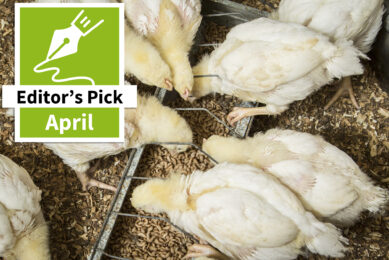Reducing antibiotic use sustainably

Sustainable reduction of antibiotics in swine and poultry requires optimisation of multiple factors unique to each species. Programmes developed by MSD Animal Health are designed to support efforts to reduce the use of antibiotics without sacrificing profitability.
The reduction of antibiotic use in food animal production has become a significant goal of all livestock producers. Livestock producers have always followed careful treatment protocols, withdrawal periods and testing procedures to ensure that animal products are not contaminated with antibiotic residues. Concerns about the development and spread of resistance genes, regardless of the judicious use of antibiotics, have created a climate where overall antibiotic reduction has become a goal of food animal producers, retailers and consumers alike. The first step toward the goal of antibiotic reduction is better preventive disease strategies. MSD Animal Health poultry and swine teams have developed programmes and tools designed to enhance disease prevention with the goal of stopping disease before antibiotic intervention is required.
Focus on the hatchery
The most common use of antibiotics in poultry production is to support marginal baby chicks that have become contaminated in the yolk sac or at the navel during hatch. Optimal hatchery equipment operation and optimal hatchery environment reduce the need for supportive antibiotics. The Convenience Programme strategy for poultry focuses on multiple aspects of the hatchery. The ‘convenience’ title means that the most critical vaccination is conveniently administered at the hatchery instead of requiring extra labour to administer vaccines in the field, but the programme is about much more than convenience. It begins with hatchery evaluations using precision tools to optimise hatchery equipment operation and environment to ensure good chick quality. The programme also includes evaluation of vaccination technique and vaccine handling at the hatchery to ensure uniformity of protection against the diseases that the chicks will face in the field, further reducing the need for antibiotic treatments when challenged later in life. Training hatchery personnel to monitor the factors critical to chick quality as well as training in vaccination technique enables poultry producers to start with healthy and strong baby chicks.
Smart vaccination
Infectious bronchitis (IB) vaccines that provide a long duration of immunity from a hatchery application and specific non-reactive DNA construct vaccines that confer life-of-flock immunity from a single hatchery injection are included in the programme. Traditional attenuated live vaccines for Newcastle disease (ND) and infectious laryngotracheitis (ILT) create significant reactions when applied to flocks in the field, exacerbated by mass application techniques such as water or spray. Another common use of antibiotics in poultry production is to counteract excessive vaccination reactions caused by imperfect administration of these traditional attenuated vaccines in the field. The IB vaccines and non-reactive DNA construct vaccines, applied with precision at the hatchery, eliminate or reduce the need for field application of live, attenuated vaccines.
Careful assessment of the disease threats facing poultry flocks is another component of the programme. Vaccination programmes are tailored to help flocks withstand challenges from variant IB viruses, ND, ILT and immunosuppressive diseases, such as infectious bursal disease (IBD), minimising both mass application of vaccines in the field and reactive products. The final result is the best protection with the least reaction, further reducing the need for antibiotic strategies.
The Go Beyond Programme for poultry goes beyond traditional disease control. Salmonella vaccines enhance food safety through reduction of salmonella contamination without the use of antibiotics. Live coccidiosis vaccination offers an alternative to ionophores (identified as antibiotics in some regions) or a sensitive strain vaccination/rotation strategy to preserve the efficacy of anticoccidial medications available to the industry. Proper control of intestinal disruption by coccidiosis reduces the need for antibiotics to support intestinal health or performance. An antibiotic reduction digital app supports the Go Beyond programme. The app provides basic information to help poultry producers reduce antibiotic use through management enhancement with respect to hatchery, disease control, ration formulation, and field management. Antibiotic reduction and especially antibiotic free production requires attention to the detail of multiple facets of poultry management. The app helps producers to focus on key critical areas to support their goals.
Overcoming challenges in swine sector
Porcine Respiratory Disease Complex (PRDC) continues to be a major economic problem around the world and, due to its complexity, the cause is often difficult to establish, while control solutions vary depending upon the production system. Antibiotic reduction requires a better and systematic understanding of the problem with respect to production management as well as the disease agents involved. Therefore, the swine team focuses heavily upon respiratory disease to help reduce antibiotic use through disease prevention. The team is particularly dedicated to PRDC prevention and control, not only through providing highly effective vaccines, but also via expert-level technical support, specific equipment and diagnostic tools. Their role is to assist producers in understanding respiratory health in their production units and also address it with tailor-made intervention strategies.
ResPig helps veterinarians and pig production professionals manage respiratory diseases that negatively impact the swine industry. It was created as a tool for veterinarians, farmers, and other swine health specialists to systematically audit farms, assess and benchmark key production indices (KPIs), to implement tailor-made solutions and eventually to receive customised training programmes according to their particular needs.
The ResPig website includes PRDC disease information, information about respiratory vaccines, and various audit tools, such as an economic simulation tool and various health audits. Careful analysis of the disease challenges and farm management is key to prevention of disease before treatment becomes necessary.
The PRRS Integrated Solutions (MIPS) programme is a tool that brings together more than 15 years of Porcine Reproductive and Respiratory Syndrome (PRRS) experience and extensive scientific knowledge of the company. It allows for a systematic review of the PRRS status in a production system based on diagnostics, biosecurity and economic audits. A proprietary feature of this tool is a PRRS cost benefit simulator that allows for estimation of PRRS cost within a farm as well as return on investment of PRRS interventions. The combined results of the audits form the basis for the development of a customised intervention and action plan.
Biosecurity also has a role to play in maintaining the health of animals in farms and the challenges within farms to manage implementation of biosecurity protocols. In addition to the biosecurity audits already incorporated in ResPig and MIPS, the B-eSecure project has been initiated which uses information and communication technologies to objectively measure people movement within a farm. In conclusion, swine and poultry are both highly intensive production systems operating on small profit margins. Reduction of antibiotic use carries a risk of economic loss if undertaken without careful analysis, monitoring, training and continuous improvement.
Authors: Linnea Newman, Global Poultry Technical Director, Miquel Collell And Rika Jolie, Global Swine Technical Directors, Merck Animal Health
Join 26,000+ subscribers
Subscribe to our newsletter to stay updated about all the need-to-know content in the feed sector, three times a week. Beheer
Beheer









 WP Admin
WP Admin  Bewerk bericht
Bewerk bericht